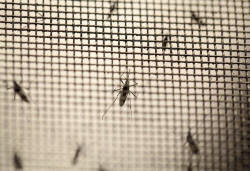|
 Genetic
study tracks start of Zika's invasion of Americas back
to 2013 Genetic
study tracks start of Zika's invasion of Americas back
to 2013
 Send a link to a friend
Send a link to a friend
[March 25, 2016]
By Kate Kelland, Health and Science Correspondent
LONDON, March 24 (Reuters) - The Zika virus
currently sweeping through the Americas looks to have hitched a ride on
a plane into Brazil in 2013 and begun its invasion of the continent from
there, scientists said on Thursday.
|
|
 In the first genome analysis of the current Zika epidemic, which has
been linked in Brazil to cases of birth defects known as
microcephaly, researchers said the virus' introduction to the
Americas almost three years ago coincided with a 50 percent rise in
air passengers from Zika-affected areas. In the first genome analysis of the current Zika epidemic, which has
been linked in Brazil to cases of birth defects known as
microcephaly, researchers said the virus' introduction to the
Americas almost three years ago coincided with a 50 percent rise in
air passengers from Zika-affected areas.
The strain of the virus circulating in the current outbreak is most
closely related to one from French Polynesia, the scientists said,
although it is also possible that Zika was introduced separately to
the Americas and French Polynesia from South East Asia.
Oliver Pybus, a biologist in Britain's Oxford University who co-led
the research with a team from Brazil's Evandro Chagas Institute,
said the findings suggested increased international travel helped
the virus extend its reach.
"We looked at broad-scale patterns of human movement and focused on
air passengers who traveled to Brazil from countries that had
reported Zika since 2012," he said. "From late 2012 onwards, there
was a 50 percent rise in the number of passengers traveling to
Brazil from countries with Zika."

The World Health Organization (WHO) has declared the outbreak of the
mosquito-borne Zika virus an international health emergency. This
declaration was largely based on evidence linking Zika to a birth
defect known as microcephaly, marked by babies having small heads
and underdeveloped brains.
It is not yet clear whether the Zika virus actually causes
microcephaly in babies, but the WHO and other infectious disease
experts say evidence for a causal link is growing.
For this study, Pybus' team sampled several Zika virus genomes
linked to the recent Brazilian outbreak – including one from a blood
donor, one from a fatal adult case, and one from a newborn baby with
congenital malformations and microcephaly.
[to top of second column] |

Using next-generation genetic sequencing, the researchers mapped the
samples' gene codes and found there was little genetic variability
among them.
This suggests there was a single introduction of Zika into the
Americas, probably between May and December 2013 – more than a year
before virus was first reported in Brazil.
Nuno Faria, a researcher at Oxford University and at the Evandro
Chagas Institute who worked on this study, said these first genomic
data from the Brazil outbreak provided "a good baseline for future
research".
He said the team had also looked for links between Zika and
microcephaly - and had found some spatial and temporal correlations.
To test that link conclusively, however, scientists need to see
results of full case-control epidemiological studies.
"There is a lot of work still to be done in terms of tracking and
predicting the spread of Zika in Brazil," Faria said. "We will have
a much better picture of the virus later this year."
(Editing by Raissa Kasolowsky)
[© 2016 Thomson Reuters. All rights
reserved.] Copyright 2016 Reuters. All rights reserved. This material may not be published,
broadcast, rewritten or redistributed.
 |